1. 10 Year UK Bonds Have Returned to Average
Jim Reid-For “positives only” week part 2 we look at the most topical global government bond market at the moment – namely Gilts.
Although there is a lot of uncertainty in the UK (LDI unwinds, BoE support commitment, terminal rate, fiscal and inflation outlook etc.), let’s look at the one big positive for Gilts and that is the rapid repricing.
As recently as 2020, 10yr Gilts were trading at 0.08% and 10 months ago were below 0.70%, the former being the most expensive in the 322 years we have data covering UK government borrowing costs. These levels flew in the face of everything you could possibly learn about long-term valuations and long-term inflation.
Fast forward to now and the rapid correction has left 10yr UK Gilt yields at around their long-term average of 4.5% for the first time since 2007, after the second largest annual correction in history behind only 1974.
While the reasons we got here are negative, at least some yield is returning to developed markets and will thus help future returns.
Is it enough? Maybe average isn’t enough but as this is “positives only” week the fact that we can have a conversation about whether value is returning is in itself a huge positive after years of there being none whatsoever.
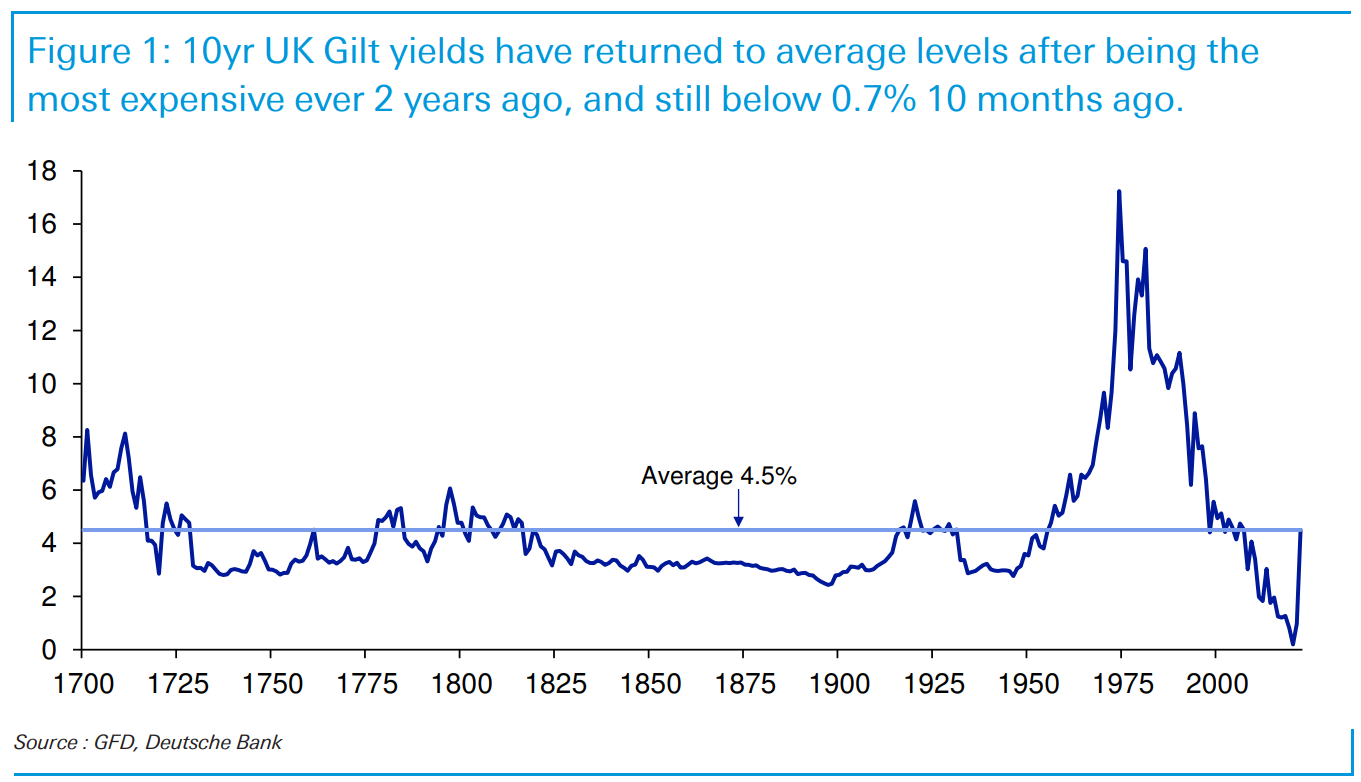
2. FX (Currency) Volatility Hits Covid Levels
From Dave Lutz at Jones Trading–As the G7 Financial ministers gather, FX Volatility and Dollar Strength have to be a big factor for discussion – The communique following this week’s meeting in Washington of G7 finance ministers and central bank governors is likely to repeat a long-standing commitment to market-determined exchange rates, European Union and UK officials told MNI. “if the U.S. could be persuaded to add an expression of concern over dollar strength, it would fall short of a signal of intervention, for which there is little support in the G7, including in Brussels” Sources said
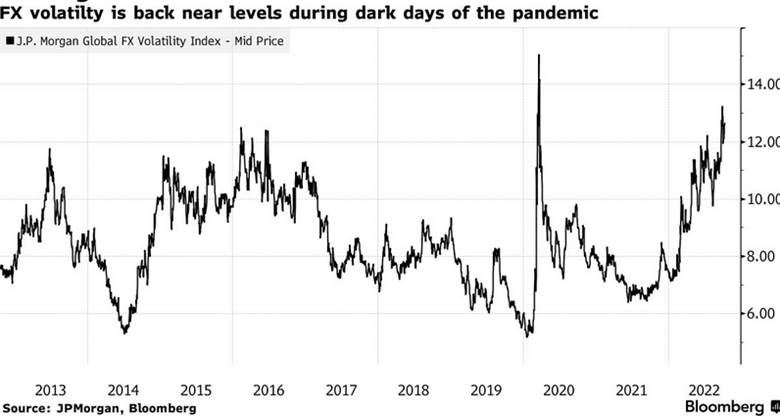
3. WSJ-Thousands of Government Exec Branch Employees Trading Stocks with Conflicts.
WSJ-Thousands of officials across the government’s executive branch reported owning or trading stocks that stood to rise or fall with decisions their agencies made, a Wall Street Journal investigation has found.
More than 2,600 officials at agencies from the Commerce Department to the Treasury Department, during both Republican and Democratic administrations, disclosed stock investments in companies while those same companies were lobbying their agencies for favorable policies. That amounts to more than one in five senior federal employees across 50 federal agencies reviewed by the Journal.
The Journal obtained and analyzed more than 31,000 financial-disclosure forms for about 12,000 senior career employees, political staff and presidential appointees. The review spans 2016 through 2021 and includes data on about 850,000 financial assets and more than 315,000 trades reported in stocks, bonds and funds by the officials, their spouses or dependent children.
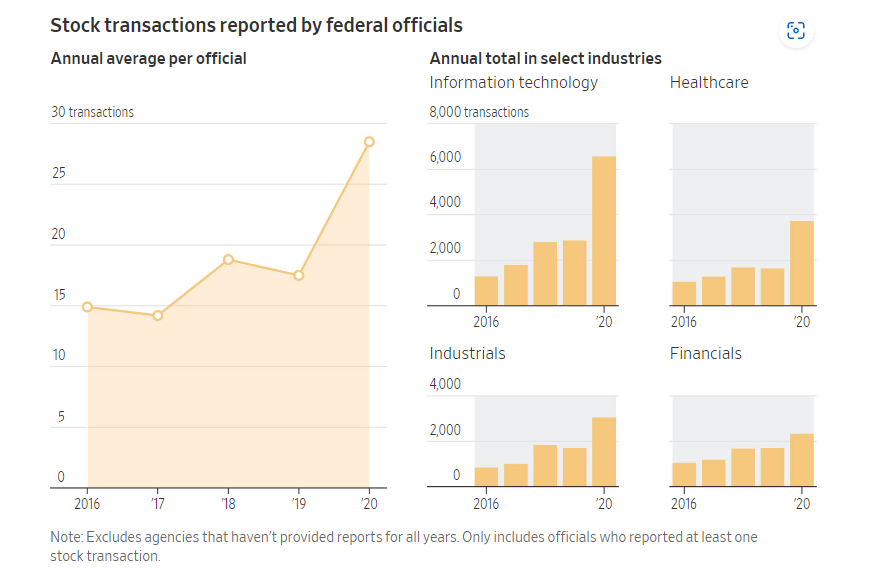
WSJ By Rebecca Ballhaus, Brody Mullins, Chad Day, John West, Joe Palazzolo and James V. Grimaldi
Federal Officials Trade Stock in Companies Their Agencies Oversee – WSJ
4. XCEM Emerging Markets Ex-China 2 Yr Return -6% vs. EEM (including China) -24%
Columbia Ex China ETF huge outperformance post Covid and Xi
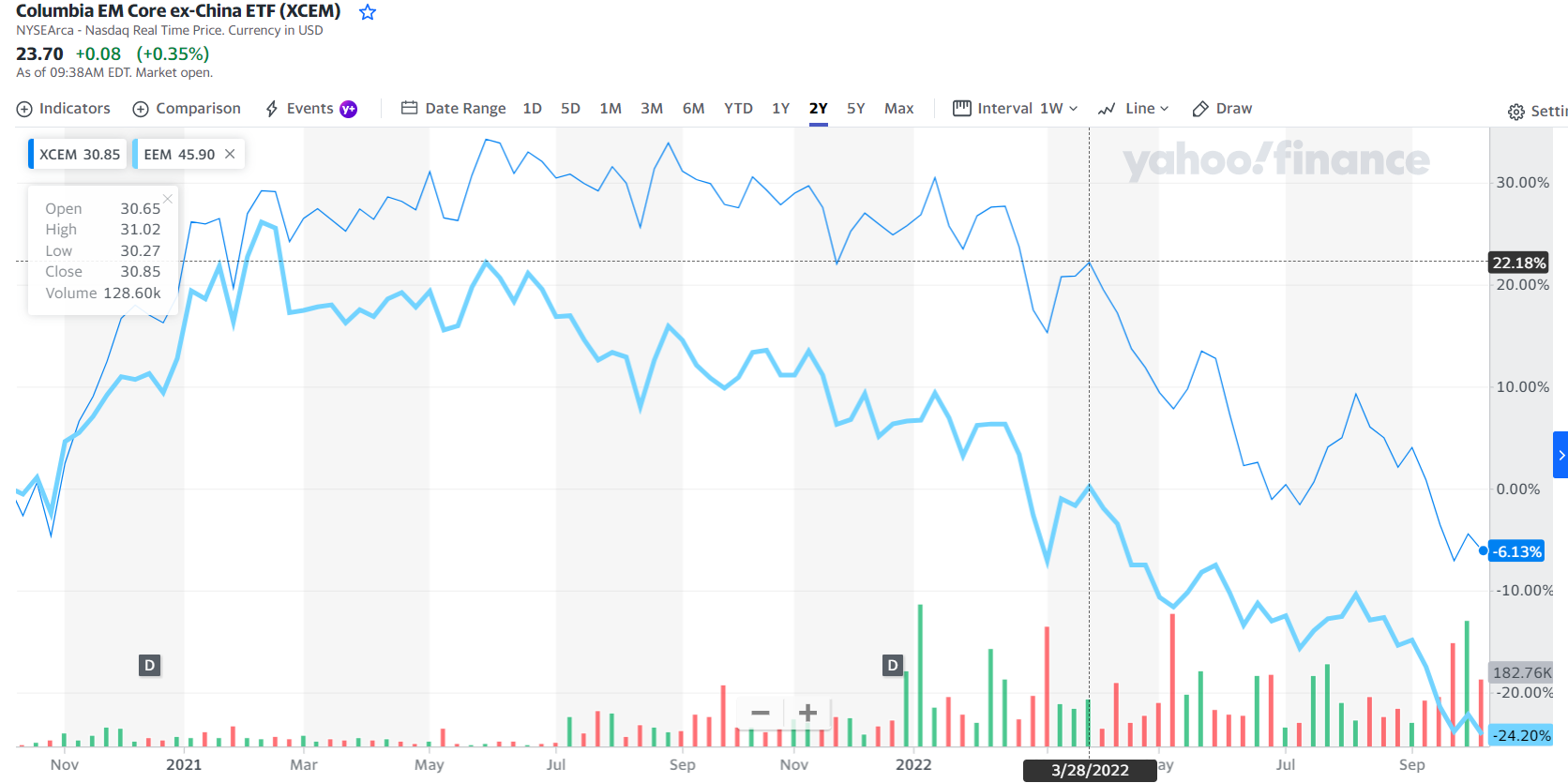
5. U.S. Government Re-Set Regarding Chinese Semiconductor Market Doing Serious Damage to Stocks
Lam Research -60% from highs…Back to Covid shutdown lows
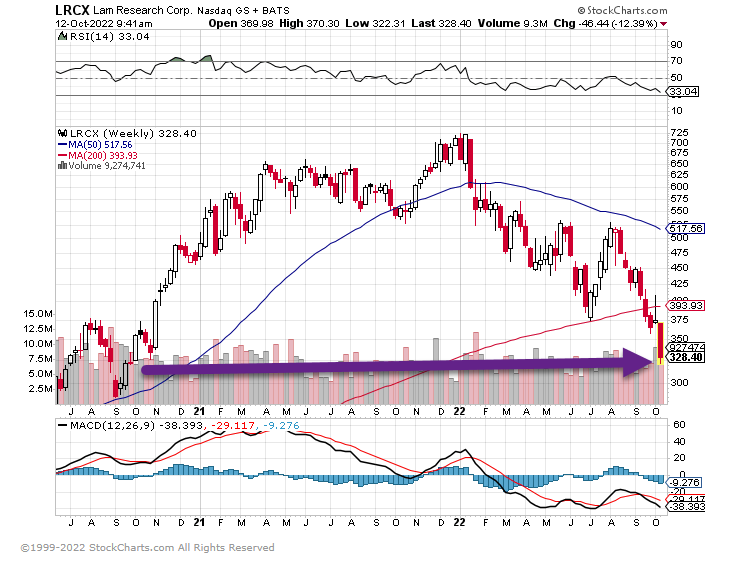
6. BYD Unit Sales Pass Tesla but Stock Down -45%

https://www.investors.com/news/tesla-stock-vs-byd-stock-comparing-ev-stocks-tsla-byddf/?src=A00220
BYD Stock -45% from Highs
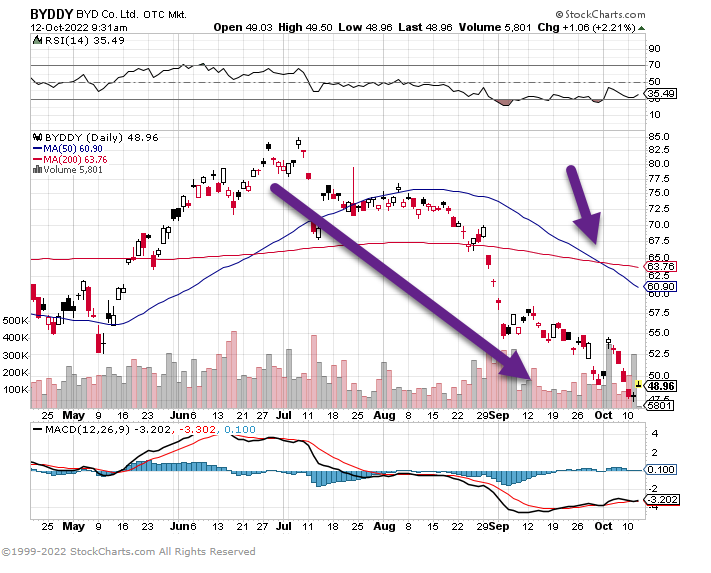
7. Post-Covid Dropoff in Personal Computer Shipments.
Chartr.com On again, off againWhether they were devices for distraction, work-from-home workhorses, or school-assigned study tools, personal computers were a hot commodity during the pandemic, with nearly 350 million shipped in 2021 — a near 10-year high.As workers and students returned to normality, however, so did the figures for PC shipments. Indeed, waning sales and supply chain issues have blighted the industry this year with shipments falling in every quarter, most recently down 15% in Q3 according to new data from the IDC’s device tracker.
Peak PC?Despite slightly different shipment counts, analysts from IDC and Gartner agree that this year’s drop offs are the most-extreme since data began to be collected in the mid-90s, regardless of which way you cut the figures.
As we split our time between various-sized screens, with smartphones and tablets becoming increasingly powerful, it’s not outlandish to say we might have seen “peak PC” even if shipment volumes are still above pre-pandemic levels. The industry isn’t in shut down mode just yet, but it is running a little slower than it did last year.

8. China Loan Growth Spike After 2 ½ Years of Negative Growth
China: Loan growth surged last month as the central bank injected liquidity into the banking system.
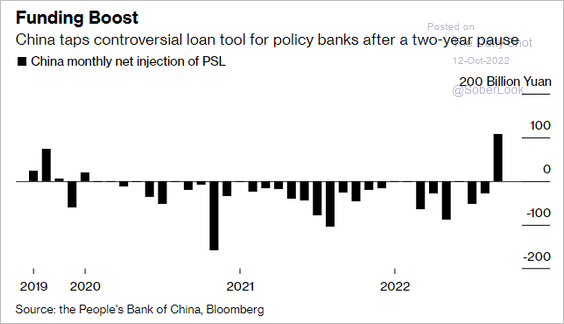
Source: Bloomberg Read full article
The Daily Shot https://dailyshotbrief.com/
9. U.S. Mortgage Rates Hit 16 Year High
Lisa Abramowicz
@lisaabramowicz1
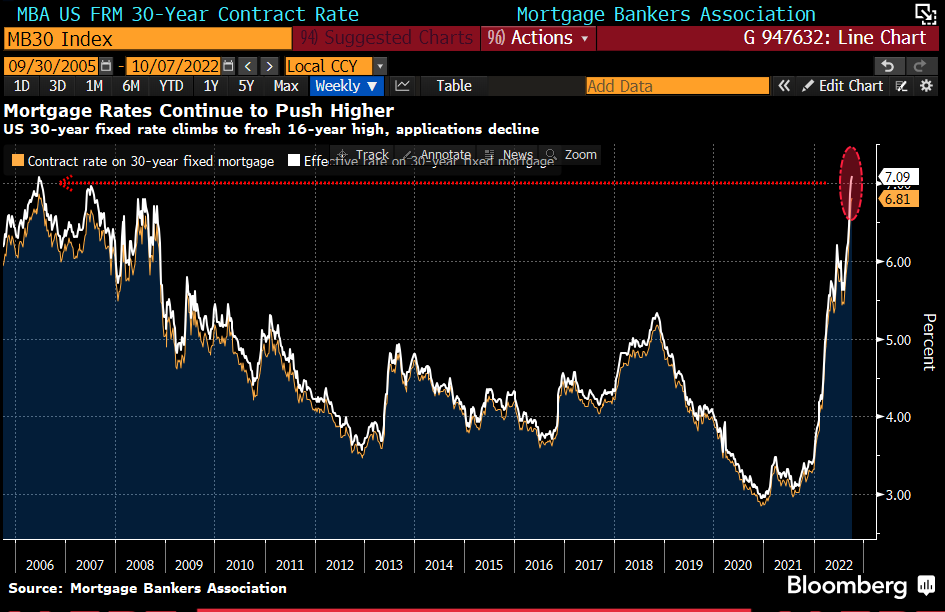
https://twitter.com/lisaabramowicz1
10. 5 Steps to Detoxify a Toxic Work Culture, According to New MIT Research-INC.
INC. A cutthroat culture will cost you employees (and money). Here’s how to change that.
BY JESSICA STILLMAN, CONTRIBUTOR, INC.COM@ENTRYLEVELREBEL
Back when just about every business pundit out there was scratching his or her head trying to figure out the causes of the Great Resignation, a team of MIT researchers decided to take a more data-driven approach. They combed through more than a million Glassdoor reviews, collating employee complaints with attrition rates to pin down what was driving people out the door.
The conclusion after all this number crunching was clear: for the type of workers that use Glassdoor at least, a toxic culture was the top reason to quit.
Your toxic or unethical culture is costing you big time.
“A toxic corporate culture is by far the strongest predictor of industry-adjusted attrition and is 10 times more important than compensation in predicting turnover,” claimed the authors, defining toxicity as “failure to promote diversity, equity, and inclusion; workers feeling disrespected; and unethical behavior.”
The diagnosis was clear, but what about the prescription? It’s one thing to know you really, really shouldn’t tolerate a toxic culture if you want your employees to stick around and thrive in an incredibly tight labor market. It’s another thing to actually understand how to change your toxic culture.
Clearly some follow-up research was needed, and it’s just been published in the MIT Sloan Management Review. The lengthy article is a must read if you suspect your culture could use some improvement, but the bottom line is that three common sense factors drive toxic cultures: bad leadership, workplace norms, and work design.
How to detoxify your company culture
That’s not hard to believe (nor particularly surprising). The more useful part of the article comes when the authors drill down and begin offering specific advice for how leaders can start to detoxify their cultures. Again, the article offers a lot more detail, but here are the first five steps suggested by the research:
- Quantify the benefits. You have a lot on your plate as a leader but as we’ve all heard a thousand times “what gets measured, gets managed.” That goes for culture too. “Keep cultural detox on the agenda by explicitly linking cultural improvements to bottom-line benefits, such as lower attrition or employee health care costs,” the researchers advise, adding: “To be clear, leaders should address cultural toxicity because it’s the right thing to do, but quantifying the benefits can help keep culture detox a priority for top teams that are being pulled in many directions.”
- Publicly report progress. It’s chaotic and demanding at the top. Don’t expect good intentions to be enough to drive change. Create some external accountability and you’re more likely to get the job done. “Top teams can invite external pressure to stay the course by publicly reporting progress against their cultural aspirations (rather than simply posting a list of core values on the corporate website),” suggest the researchers. That might mean publicly disclosing Equal Employment Opportunity Commission diversity data, for example.
- Model good behavior. Employees will ignore what you say and simply copy what you do. Employees “tend to discount lofty statements about abstract values. Instead, they closely observe what leaders do for signals about what behavior is encouraged, expected, and tolerated,” say the researchers. “When leaders act consistently with core values, however, it is one of the most powerful predictors of how positively employees rate their corporate culture.”
- Seek out honest data. One of the perils of leadership is becoming insulated from bad but important news. ”In a survey of 16,000 managers across nearly 500 companies, top executives were 24% more likely to say that they addressed unethical behavior quickly and consistently compared with how well middle managers thought the C-suite dealt with unethical actions,” the researchers report. So look for ways to get unvarnished feedback on how you’re progressing, including from sources like Glassdoor.
- Coach your managers on how not to be toxic. There isn’t a huge amount of evidence showing coaching can eliminate toxic behavior (true jerks may simply have to be fired or at the very least not promoted), but the authors suggest it’s worth a try. They also cite research that suggests reminding managers about the negative impacts of bad behavior and being crystal clear about what constitutes toxicity encourages them to act in ways that help employees stick around and thrive.
There are no magic bullets or overnight successes when it comes to something as tricky as overhauling your culture. But this MIT research suggests detoxifying a toxic workplace isn’t a hopeless task either (just ask Satya Nadella).
Bad norms can’t be eliminated by just removing a few bad actors or writing down new values, but they aren’t somehow part of the water you drink or the air you breathe either. Leaders can turn around a toxic culture as long as they think strategically and follow through with commitment.